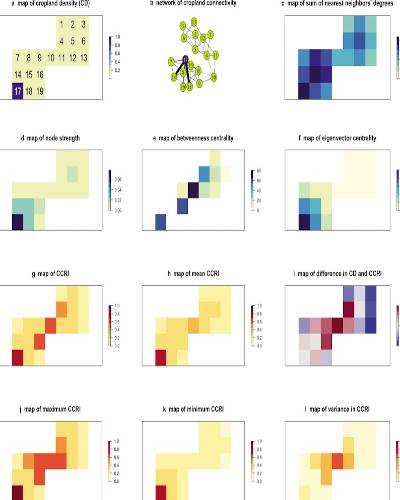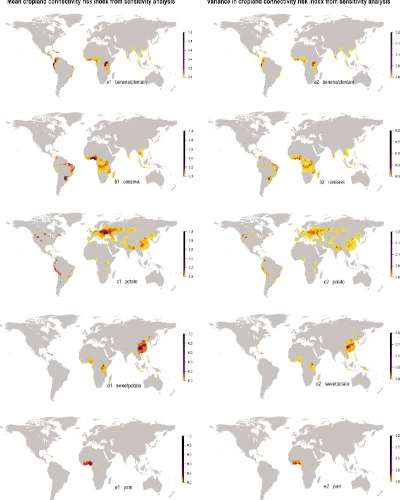By DeLene Beeland
People who evaluate food crops for risks have a new tool in their toolbox: global maps showing where five staple crops face the threat that emerging diseases or pests may readily spread.
In a new study published in BioScience on July 29, UF preeminent professor of plant pathology Karen Garrett and a team of international researchers reviewed current disease and pest risks to potato, cassava, sweet potato, yam and banana/plantain. They also proposed a new model for assessing the risk from pathogens and pests to these crops globally and prioritized key areas for surveillance and mitigation.
Risk assessments for crop pathogens commonly evaluate factors such as climate, weather and trade routes. But the global role played by habitat connections is often overlooked in agriculture.
“It makes logical sense that where there are more crops, there is more risk. A lot of people think about this,” says Garrett, who holds positions with UF’s Institute of Food and Agricultural Sciences, College of Agricultural and Life Sciences, the UF/IFAS Institute for Sustainable Food Systems and the Emerging Pathogens Institute. “But what we show is that there is also more risk where habitat bridges connect croplands. These bridges can make it easier for a pathogen to move.”
Just as wildlife corridors link habitat patches for a variety of species, connected croplands also allow pathogens and pests to spread.
UF scientist Yanru Xing and former UF postdoctoral scientist John Hernandez Nopsa are the co-first authors who implemented the cropland connectivity analyses. Garrett is the study's senior author, and both Xing and Nopsa are current and former members, respectively, of her lab.
Garrett and her team used a method known as network analysis to evaluate connections between cropland regions. This approach is more common in studies of people’s social networks, behavioral interactions and public health, but Garrett is helping to bring the method's benefits to plant pathology research. She and her colleagues have used it to evaluate how invasive pathogens spread through potato and sweet potato seed trade routes, to study interactions between hosts and pathogens in papaya orchard viromes, and to evaluate candidate biocontrol communities.
“The concept of network analysis is not yet a standard part of everyone’s toolbox for crop pathogen management,” Garrett says. “But in this study, we made a generalized map for anyone who is thinking about how to manage pathogen risks to these five crops. Even if they are not going to develop elaborate new models of their own, they can use these maps to zero in on which locations are likely to be priorities for surveillance."
How it works
Their model represents planted crop areas as a grid of “pixels,” then evaluates factors such as how densely planted each pixel is, how closely connected pixels are to each other, if a pixel has to be traveled through to reach other pixels and if it forms a bridge connecting pixels. Think of it like this, the analysis describes cropland areas as either sinks or sources of pathogens—places where pathogens reach a dead end, or a launchpad.
The model also incorporates characteristics for different crop pathogens and pests, such as how likely they are to disperse longer distances, to estimate how pathogens may spread within a connected cropland network.

The team then used the network analysis approach to evaluate which pixel “nodes” are linked to other nodes, and how strong each node’s connection is in comparison with others. For example, a node representing a densely planted pixel that acts as a connecting bridge to other pixels has a higher risk index in comparison with a node that is less densely planted, doesn’t bridge to other planted areas, and doesn’t need to be frequently traveled through to get to other regions with the same crop.
By evaluating these varying factors, the team then came up with a cropland connectivity risk index, or CCRI, indicating a given area's risk. A higher CCRI value equates to a higher level of risk for new invasions of a disease. Or, if the disease is already present but not yet widespread, then highly connected areas are more prone to become saturated with the pathogen.
Usefulness to crop managers
In the past, attention has often focused on when pathogens emerge in a specific place, but less is paid to the process by which a pathogen becomes widespread. The team’s model shows how a high CCRI value for cropland connectivity is a risk factor for disease saturation—information that can be used to ensure food security.
“This is the first time anyone has applied an analysis like this to the global crop system for these five key food security crops,” Garrett says. “The idea is to give managers and people who have an eye on protecting these crops an additional tool they can use to better allocate resources for surveillance.”
While some previous models have used network analysis to evaluate single crops or pathogens in limited geographical areas, this is a new approach to evaluate multiple pathogens and crops over the entire globe based on the role of cropland connectivity. One of Garrett’s goals is to make the analysis of cropland connectivity a standard component of risk assessment that is straightforward to use.
The team’s risk maps can be combined with other risk maps that look at single factors such as climate, weather or trade routes.
“There could be a spectrum of applications. On one end, I imagine people might blow up a map of cropland connectivity for their country, and then use it as one factor in considering what areas need special focus for risk management,” Garrett says. “On the other end of the spectrum, someone could feed our maps into their GIS systems to formally combine them with other risks they are focusing upon, such as climate-based risk.”
Mapping regional focal areas for risk
The new study offers a preview of how their model can generate risk analysis maps that pinpoint areas of focused risk. Explore the map below and the summary of highly connected geographical areas that are likely to be important for the spread of pathogens and pests for each staple food crop.

- Banana/plantain: central, northcentral and southern Uganda and NW Tanzania, Rwanda, Burundi, parts of Colombia, Ecuador and Haiti. (The highest global CCRI was found in the border region of Uganda, Rwanda, and Tanzania.)
- Cassava: southern Nigeria, southcentral Ghana, western Burundi, northern and southern Brazil southwest Paraguay, and northeast Argentina
- Potato: northcentral Europe, including northern and central Ukraine, central Poland, central and southern Belarus, and southwestern Russia
- Yam: southcentral Nigeria, Benin, Togo, Ghana, and the Ivory Coast, along with locations in the Caribbean including Haiti
- Sweet potato: central China, the Caribbean (Haiti and the Dominican Republic), central Uganda, central China (this area ranked the highest globally for risk)
Garrett notes that the work would not have been possible without the help of an internationally recognized team that includes global experts in the study’s targeted crops and pathogens. The international agricultural research organization CGIAR also provided funding and support, as part of the CGIAR Research Program on Roots, Tubers and Bananas, as did the Bill and Melinda Gates Foundation.
Source : ufl.edu